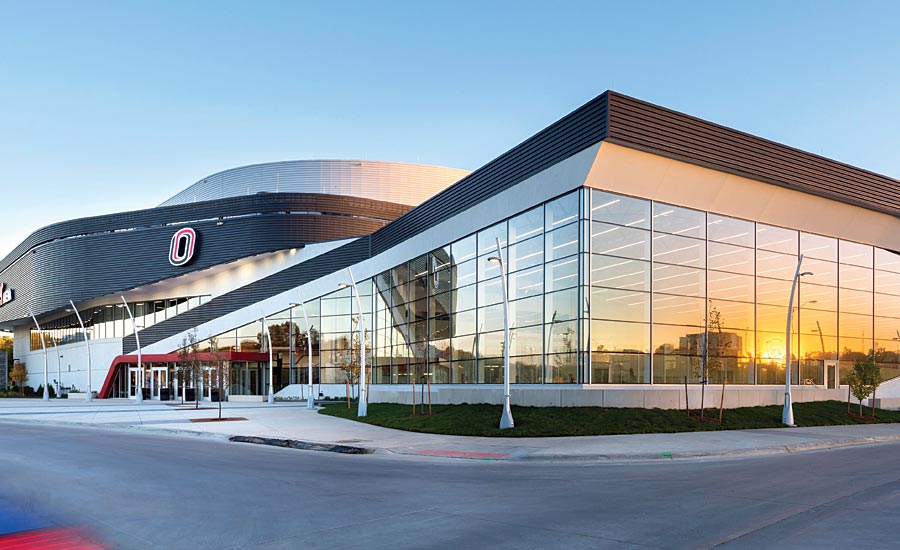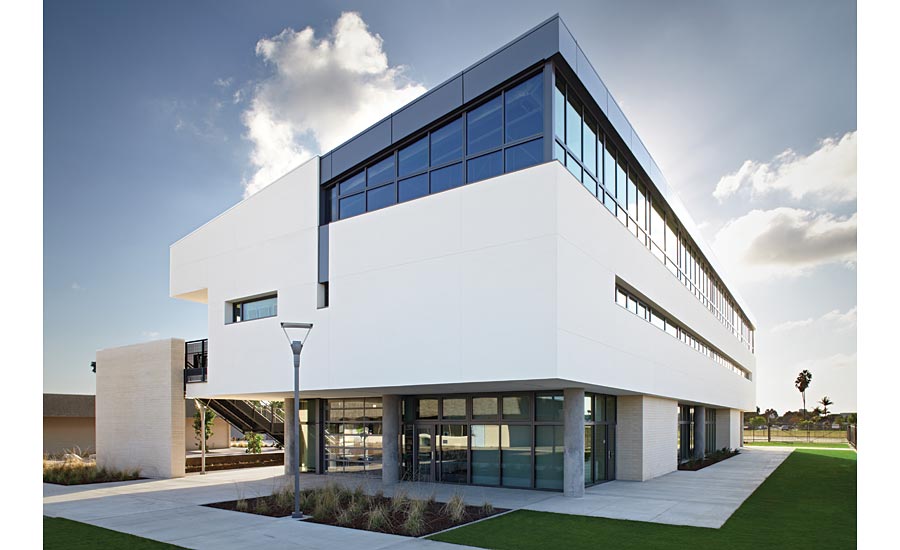Installation of XPS Insulation in EIFS Facades
XPS Insulation and EIFS? Absolutely!

Baxter Arena in Omaha, Neb., utilizes StoTherm ci XPS.
- StoGuard
- Sto TurboStick Adhesive
- Dow STYROFOAM Panel Core 20 or Owens Corning Foamular CI-C Insulation
- Sto Mesh
- Sto BTS Xtra Base Coat
- Sto Primer
- Sto Finish

StoTherm ci Essence.

The Post Midtown multi-family project features StoTherm ci Essence.


The Helen Stacey Middle School in Westminster, Calif., with Stolit Milano.





From tested, full system integration of the air and moisture barrier in the EIFS assembly to the different basecoat and mesh options available based on the impact resistance needs of the building, EIFS has shown a continuous ability to meet the aesthetic and durability requirements of building professionals and their clients. At times however, we take for granted an important component of EIFS: the insulation layer.
Considering the need for buildings to meet or exceed stringent energy codes (Title 24, IBC, IECC, ASHRAE 90.1), we should remember that EIFS is the original continuous insulation cladding and is an ideal solution to bundle up all of the design and performance needs for the exterior wall in one simple assembly. In addition, and with regard to the insulation layer, it is important to recognize that expanded polystyrene is not the only option for EIFS. Extruded polystyrene is a popular and desirable insulation choice for architects and building owners, and recent adhesive technologies help simplify the installation of XPS in EIFS facades.
What about Class?
It can be difficult to think of XPS as the insulation layer in an EIFS assembly. Historically, XPS was not used as a component in this cladding, instead finding itself used in Class PM EIFS. These systems utilized expansion and control joint accessories similar to stucco as the fiber reinforced Portland cement basecoat was 1/4-inch thick and fairly rigid. In addition, XPS insulation was mechanically attached to the supporting structure as opposed to adhesive attachment with Class PB EIFS. The lack of regulation requiring continuous insulation and the challenges with installing these systems led to it exiting the market quite a few years ago.
Today, the challenges with past Class PM Systems are gone. It is no longer necessary to install the thick, rigid basecoat lamina; in addition, the insulation can be adhesively attached and does not require the use of mechanical fasteners anymore with some manufacturer’s systems. In other words, EIFS with XPS is similar to the installation steps of traditional EIFS and removes any potential confusion as to how the system is designed and constructed.
For design professionals, having the ability to produce details that easily connect adjacent materials to the façade is critical. The modern day EIFS system with XPS, due to its similarity to traditional EIFS, aids the designer with this objective. For the applicator, the ability to construct these details in the field without having to perform law-defying physics in material capability is beneficial as well considering the compressed construction schedules and labor shortage most markets currently experience. In addition, new technologies we are experiencing today with something as simple as a fast curing insulation adhesive can add additional benefits.
How to Adhere
Polyurethane adhesives are nothing new yet there are some manufacturers who have advanced the technology in order to provide a modern, faster, simpler and more cost-effective methods in which to adhere XPS insulation to their air and moisture barrier. How do they do this?
- Speed of construction: polyurethane foam adhesives are fast curing, which means the XPS can oftentimes be rasped the same day.
- Less is more: one cylinder replaces ten pails of basecoat. That is a lot less material storage, handling, disposal, an important feature given that jobsites that have less area to store materials.
- Lightweight: Approximately 15-20 oz. of polyurethane adhesive replaces one bag of basecoat, which practically eliminates the labor-intensive handling of heavy basecoat bags.
- Testing, testing, testing: any adhesive, or for that matter, any material utilized in an EIFS assembly or cladding requires testing for compliance and more importantly, testing for compatibility, performance,
and longevity.
Perhaps the best way to describe it is: A lot of engineering is involved in order to make sure connectivity and compatibility of these materials are at their optimal level of performance. As alluded to earlier, EIFS is more than the observable finish layer. All of the materials, previously referred to as “guts,” are engineered to work together and perform as a multi-functional all-in-one façade assembly.
So where does XPS insulation play a role in all of this? As you can see, there are more components playing critical roles across the building exterior and choosing the right system requires prioritization. There are benefits to XPS (nominal R5 per inch and its high compressive strength for example) that are more significant today as municipalities adopt energy codes and therefore, rely on insulated exterior systems and claddings (EIFS anyone?) to meet the tighter standards.
XPS products are leading the charge because they—besides their known attributes—contribute toward optimizing the exterior CI system’s energy efficiency; minimizing heating and cooling costs to maintain the comfort level for the building’s occupants; additional monthly cost that may easily offset the initial investment cost. The ability to choose between different types of insulation within one system allows designers to choose the level of durability, occupant comfort and monthly energy cost that suit their project.
In addition, for building exteriors designed with multiple claddings, the use of one type of insulation and sub-components across the building envelope is beneficial, as well. If XPS is used behind a non-EIFS cladding, the ability to connect with EIFS using XPS is potentially less of a challenge. To further this thought about compatibility, the air and moisture barrier can be continuous too as opposed to attempting to connect different AMB systems behind the insulation.
So where does the choice of insulation rate in the overall building science equation? Looking at the insulation as a standalone product is not the answer, it is important to choose a system that effectively integrates the insulation. Various stakeholders in the design and construction of a building are looking for an insulated wall solution that is easy to work with while delivering the expected performance levels in a certain period within a certain budget.
For Future Reference
When working on the next project ask yourself: How quickly and easily can I effectively tie the different wall systems (e.g. the system requires brick and stucco) on one exterior wall together? Can I avoid thermal bridges in the system, allowing for the continuous insulation the building code is requiring? Am I able to effectively install the air and moisture barrier?
EIFS with XPS is an excellent system and solution to the challenges just described. The system consists of various components to create functional layers within an engineered, elegant and simple assembly coming from a single source. These layers help to address airflow, moisture penetration, continuous thermal performance and impact resistance. The topcoat layer is a decorative, flexible trowel or spray applied finish that allows for a dizzying array of colors and looks; effectively eliminating the connection and compatibility challenges that other systems often create. Instead, you are able to provide the look of commonly used systems such as brick, limestone, concrete or simply use the finish as a standalone design staple creating a modern ultra-smooth or textured exterior façade.
Looking for a reprint of this article?
From high-res PDFs to custom plaques, order your copy today!










